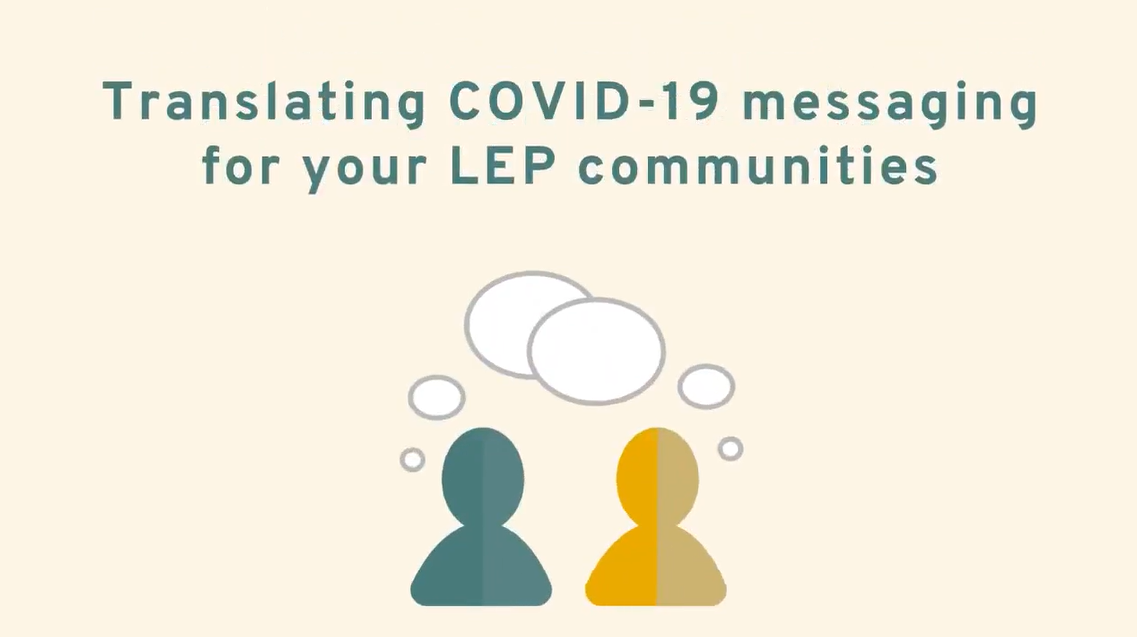The Rise of Telehealth and Language Services After COVID-19
The COVID-19 pandemic has changed many aspects of healthcare. One of those aspects is routine doctor visits. While many health issues still need to be handled in person, others can be done online through telehealth services (also known as telemedicine). Telehealth lets you talk to your healthcare provider live over the phone or video chat, send and receive messages using a secure online system, and use remote monitoring for updates. But if patients can’t speak English and the provider isn’t bilingual, what happens then?

Telehealth services have grown exponentially since the pandemic. A study by the Office of the Assistant Secretary for Planning and Evaluation (ASPE) found that the number of Medicare visits conducted through telehealth appointments increased 63-fold, from 840,000 in 2019 to 52.7 million in 2020. Also, the number of behavioral telehealth appointments increased 32-fold. Telehealth is here to stay.
Telehealth remains an important part of the modern healthcare system, but how can providers navigate the complexities of offering patient care if they cannot understand the patient?
Table of Contents
Advantages and Disadvantages of Telehealth Services
Offering Telehealth Interpretation: Compliant Support for Patients
What Are the Different Types of Interpretation?
Improve Healthcare Literacy Through Language Along the Patient Journey
Determine the Best Solution for Your Patient’s Need(s)
Frequently Asked Questions About Telehealth Interpretation
The Importance of Language Access Needs for Telehealth Services
Advantages and Disadvantages of Telehealth Services
Telehealth offers many advantages, but it also highlights the gaps in language access, digital literacy, and Wifi accessibility, and thus health disparities, that can impact the health of those with limited English proficiency (LEP). While healthcare organizations may not be able to address some technology issues, they can implement language access solutions in telehealth and the patient journey overall.
Telehealth has advantages and disadvantages for healthcare organizations and patients.
Advantages include:
- It can better reach those in rural communities who may not otherwise have healthcare or access it easily.
- It’s easier for those who might have to take time off work, arrange child care, find transportation or other challenges.
- It saves time and precious resources during labor shortages and an extremely overloaded healthcare system due to COVID-19 and patient backlogs.
- It frees up money for other types of languages services.
- It enables healthcare providers to widen the net for interpreters for those languages that might be challenging to secure onsite.
Disadvantages include:
- Historically marginalized communities, like those with LEP, tend to have lower rates of internet access and digital literacy.
- For those who have internet access, there are higher rates of broadband.
- Those in rural areas may not have access to broadband WIFI, or dependable service.
- Older patients often have higher levels of healthcare needs, and it may be more critical for this population to have online appointments instead of in-person. Yet older patients have even lower rates of internet access and digital literacy.
- People may not feel comfortable with having their medical information online.
Let’s look at one of these language barriers: digital accessibility for those with language needs. Unfortunately, this barrier can exacerbate disparities in the healthcare system. For example, one primary care clinic that usually had 14% non-English speaking patients noted that the numbers dropped to 7 percent when operating only as telehealth during the pandemic.
Healthcare organizations won’t be able to make internet access more accessible, but they do have options for improving language services. So how can healthcare organizations close equity gaps when addressing barriers in telehealth and digital access?
Offering Telehealth Interpretation: Compliant Support for Patients
For healthcare appointments, providers need to meet language access laws. This includes telehealth, which poses some changes to the new landscape such as accessing remote interpreters, digital literacy, technology, and (Personal Health Information) PHI security.
Providing interpretation services, whether they’re through video remote interpretation (VRI) or over-the-phone (OPI), is critical for improving language access. Healthcare providers should have established language agencies with the setup for appointments and last-minute needs. A language service provider (LSP) can help strategize your needs to efficiently meet video appointments and larger volume calls.
What Are the Different Types of Interpretation?
- Video Remote Interpretation (VRI) – Interpretation that occurs virtually through technology that allows audio and visual communication.
- Over-the-Phone Interpretation (OPI) – Interpretation that happens over the phone, so is only audio–based.
- Onsite Interpretation – Interpretation in which the participants and interpreter are at a physical location to interpret in front of all participants.
Learn about OPI vs. VRI interpretation, and why you may need to provide both types of telehealth interpreting to patients.
Improve Healthcare Literacy Through Language Along the Patient Journey
To improve healthcare literacy through language, consider patient touchpoints with your organization. The patient journey starts with searching for providers, having an initial appointment, and aftercare, including self-administration of care, and all the touchpoints in between. When you think about the patient experience, ask yourself these questions:
- At what point does a patient identify their language access needs?
- How can a patient make an appointment?
- Does the phone system have an option for language assistance in a language other than English?
- If a patient gets voicemail, is it in English or are there other options?
- Who can a patient speak to for general questions?
- How does a patient respond to appointment confirmations?
- Can a patient easily reschedule?
- At the very beginning of an appointment, can someone help a patient with the paperwork or administrative work?
- After the appointment, who helps a patient set up the next appointment?
- Who does a patient call if the patient needs to clarify instructions?
If you identify areas that need improvement with language, consider strategizing with your LSP. For example, perhaps you should localize your website or create language voice options on your phone system, and your LSP can help you with that.
Determine the Best Solution(s) for Your Patients’ Needs
One language scenario may not be enough to fulfill your patients’ needs. Given the disadvantages that we described earlier, and as COVID-19 continues to challenge traditional healthcare solutions, healthcare organizations may have to more than one language strategy for given scenarios.
Technology Considerations
For example, telehealth appointments may not be the best solution in some cases. With VRI, consider the following factors to have a successful meeting:
- High-speed internet and bandwidth connections
- High-quality full motion and audio equipment with knowledgeable users
- High-quality images
- Positioning and clear images of all individuals
- Adequate digital literacy to use the technology on all sides
Consider other telehealth options where video conferencing technology won’t be as much of a challenge. For example, some LEP patients may be more comfortable over the phone than on video. The AHA 2022 Environmental Landscape showed that of the 27% of Medicare beneficiaries who participated in telehealth visits, 56% were over the phone, 28% were video, and 16% were both.
Appointment Types
Of course, some types of topics are better for telehealth than others. Here are some examples.
- OPI/VRI – General wellness visits, management of chronic conditions, discussion of test results, counseling about diagnostic and therapeutic options, dermatology, prescriptions for medicine, nutrition counseling, and mental health counseling.
- Onsite – Health concerns that require a procedure, abdominal pain, eye complaints, gynecologic complaints, dental complaints, highly nuanced or multiple complex health concerns, and any situation in which a physical exam would change the recommendation (Telehealth for Providers: What You Need to Know, By From Coverage to Care, March 2021)
Language Considerations
Lastly, consider language factors, such as requests by the individual for a specific language and method, complexity of the meeting such as multiple participants which can be confusing on video or phone with interpretation, the digital literacy of all participants, limited hearing by participant(s), sign language users (meaning OPI isn’t a possibility), and more.
Frequently Asked Questions About Telehealth Interpretation
How will clinicians know whether they will need a healthcare interpreter present before a visit?
Clinicians can determine the need for a healthcare interpreter by reviewing patient records in the EHR system, noting the patient’s preferred language, or asking patients directly when scheduling an appointment. On-demand interpreting solutions and medical interpretation services are available to ensure equal access and health equity, so clinicians can plan ahead and provide professional interpreters for both in-person and telehealth visits.
How do telehealth interpreters join an appointment?
Telehealth interpreters will join appointments via secure links hosted on the AvantInterpret on-demand interpreting platform. Professional interpreters are trained to provide real-time interpreting, supporting patients who are hard of hearing, speak a different language, or need ASL services, all while maintaining accuracy in medical terminology.
Is having a medical interpreter present HIPAA-compliant?
Yes. All professional interpreters engaged through Avantpage’s medical interpretation services adhere to HIPAA standards, maintaining patient confidentiality at all times. Whether interpreting face-to-face, via video interpretation, or in real-time telehealth sessions, interpreters are trained in medical terminology and confidentiality protocols to protect sensitive health information.
Does AvantInterpret integrate with EHR systems?
Absolutely. Our interpreting platform integrates seamlessly with EHR systems, allowing clinicians to schedule appointments, track patient data, and request medical interpreters directly within the platform. This integration supports real-time, on-demand interpreting solutions and helps ensure that patients receive care in their preferred language without workflow disruption.
Are ASL interpreters available for telehealth appointments?
Yes. ASL interpreters are available for telehealth appointments to provide equal access and support health equity for patients who are deaf or hard of hearing. Interpreters join in real-time via video interpretation, ensuring clear communication and seamless integration with clinicians’ telehealth workflows.Learn how to work with a sign language interpreter for better health outcomes for patients.
The Importance of Language Access Needs for Telehealth Services
Telehealth services are going to continue to grow. To reduce health disparities in language, healthcare companies can provide interpreters, address language needs along the patient journey, and evaluate the best solutions for their patients.
We provide VRI and OPI services for healthcare organizations and other industries. To learn more about how we can help you, get a free quote, contact us with a general inquiry, or call (530) 750-2040.


